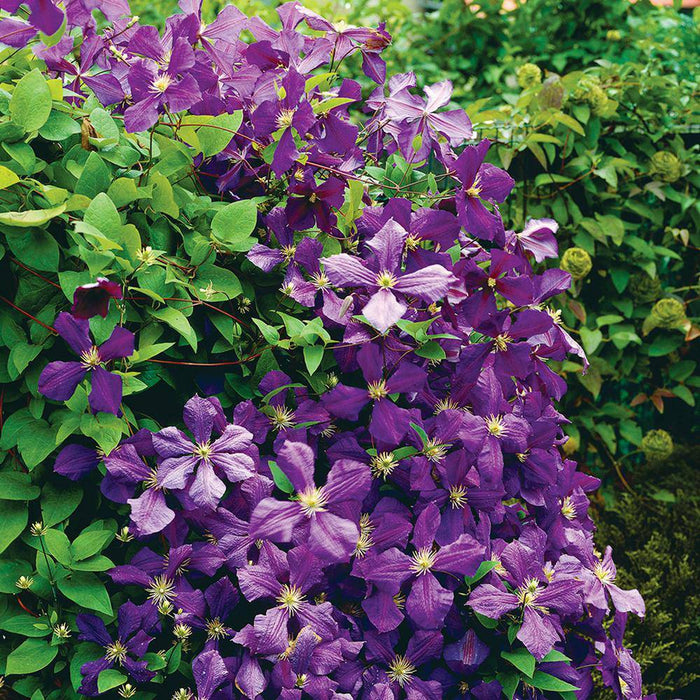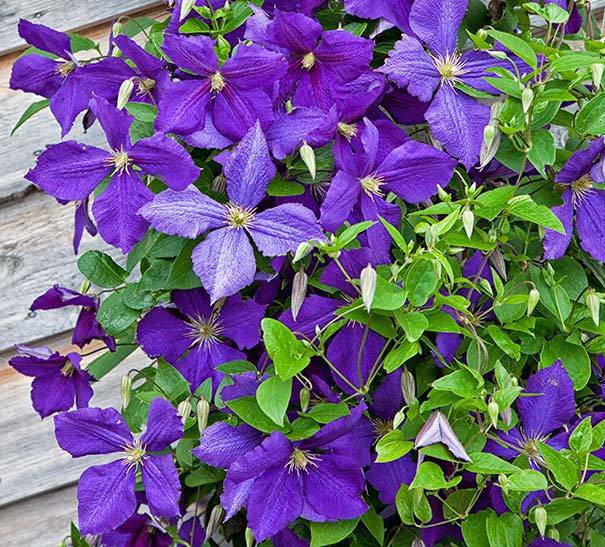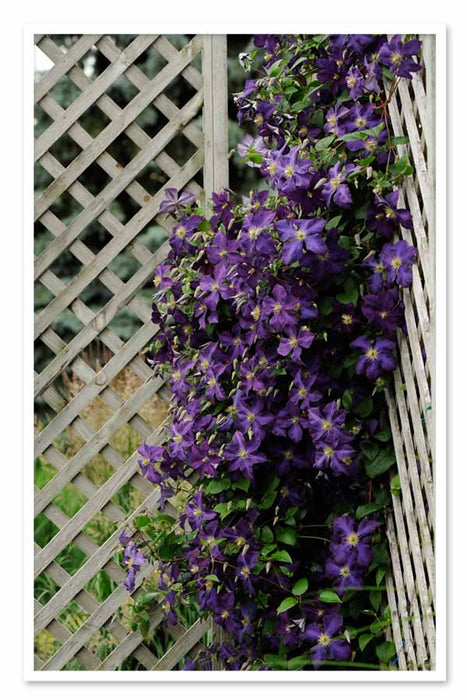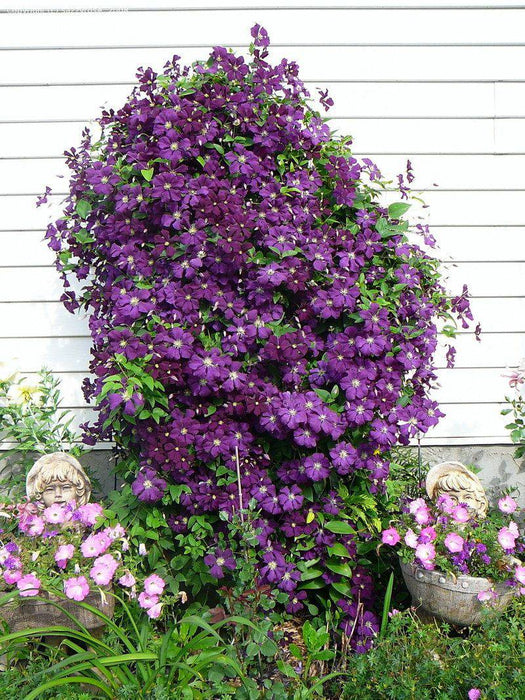
Clematis Jackmanii ( 2.5' POT) Large-flowered Vine
Most orders are processed by the next day
Select your desired size and/or color from the available options.
Dormant Bare Roots
We usually ship perennials to you in their dormant state, that is: bare roots, usually without leaves, packaged in damp peat moss in plastic bag.or in 3' pot of loose soil. They may have some shoots beginning to grow Trim off any stems that have sprouted on your bare-root clematis back to 12 inches if any longer than that have sprouted from the crown. This helps prevent breakage, gives new roots less plant to support while establishing and promotes branching once the plant starts to put on new growth. . It is very important to plant these dormant perennials as soon as possible after you receive them. If it is absolutely necessary to store them for a short time before planting them. If the roots appear dry, soak them for a few hours in warm water. Thereafter store in slightly moist soil in a cool, but not freezing location until you can plant.
Jackmanii’ has 5-6″ spectacular, dark, violet-purple, semi-nodding flowers with green stamens that are borne in great profusion from July to October. It is popular and reliable. This vine grows best in a fertile, well-drained, alkaline soil. A choice site is key to the success of establishing this perennial; roots should be kept cool and moist.
Clematis 'Jackmanii'The classic variety, considered by many to be the truest (and most beautiful) Clematis of all! A spectacle from June through August -- that's 3 full months of bloom!
Near Countless Blooms Grow at Your Bidding. Jackmanii Clematis puts on a show all summer long. Strong vines hold so many flowers you won?t believe your eyes. Foliage is deep green and provides a tasteful backdrop for a flood of royal purple flowers that may reach nine inches across. ?Queen of the Climbers? is often how Jackmanii is described and for good reason. No other clematis produces blossoms as large for as long as this variety.
Jackmanii is probably too popular for you to think of as an heirloom variety, but its history here is long and rich. It was imported from English gardens in the 1850?s. Gardeners love Jackmanii for its flexibility and reliability. Use this cultivar as a screen to block an unpleasant view, let it climb the mailbox post or drape over a stubborn stump. Jackmanii is happy to twine itself through rose bushes, dogwood trees or any number of standing shrubs. In the house, enjoy Jackmanii's blossoms in a bowl of water, an elegant focal point for your table.
This clematis prefers light shade. Jackmanii belongs to pruning group 3, so you?ll cut it back each year to grow new wood and a tidal wave of blossoms each season
GROWING
Soak your bare-root in a bucket of water for at least one hour.
- Fill a 1-gallon pot half full with moist potting soil. Create a cone of potting soil in the bottom of the pot. Bare-root clematis establish better with their roots slightly constricted in a pot, than lost in a the wide-open soil, according to the International Clematis Society.
- Spread the roots around the the soil, adjusting the plant so the crown -- where the plant emerges from the roots -- will be 2 inches below the soil line, or about 3 inches from the pot's rim.
- Insert a bamboo stake just behind the plant and its roots in the pot to support any new growth. Water the plant in well. Place the pot in a protected area that receives morning sun. Provide 1 inch of water per week.
- Fertilize with a handful of 5-10-10 fertilizer when new growth is approximately 2 inches long. The low-nitrogen fertilizer puts nutrients into root development, rather than top growth. Plants are putting their energy into root growth at this point. Don't expect to see much growth up top in the first season, but prune back any stems that grow longer than 18 inches.
- Dig a hole 2 feet wide and deep in the plant's permanent location in early fall. The ideal location has sun with afternoon shade or dappled sun and soil that drains well. Plant near a trellis, arbor or other support.
- Mix peat moss, native soil, and compost and place the plant in the hole so it is at the same level as in the transplant container.
- Water in well and provide 1 inch of water per week.
- Fertilize annually with 1/2 pound of 15-5-5 fertilizer applied in the 50 square feet around the plant.
- Prune early flowering clematis varieties with hand pruners immediately after flowering.
- Do not cut into woody growth. Late-flowering types are pruned immediately after flowering back to 2 to 3 feet tall, once mature. Cut back large-flowered types, which bloom on new and old wood, on late spring, by removing old wood and in summer by cutting the plant back to 18 inches tall after blooming.
Tip
Plant clematis with darker or striped flowers where they won't be bleached by afternoon sun.
CARING FOR CLEMATIS AFTER THEY BLOOM
After the flowers fade, some clematis develop decorative seed heads. These can be left in place throughout the growing season. Though it's not necessary, you can also cut off the seed heads to keep the plant looking neat. Some clematis varieties bloom again in late summer or early fall. If you think your clematis could be a rebloomer, remove only the spent flower heads and avoid cutting back the foliage.
Early spring is the best time to prune a clematis. There are two approaches to pruning. Some varieties produce new growth on last year’s vines, so they should only be pruned to shape the overall plant. Others varieties die back to the ground. Since any new growth comes from the base of the plant, all of the prior year's vines can be removed. Until you get to know your clematis, it’s best to wait until the plant has sprouted new growth. That way you can see where it's coming from and prune accordingly.
Fertilize your clematis in the spring when the first leaves start to unfurl. Follow package instructions, sprinkling approximately ¼ to ½ cup of all-purpose granular fertilizer around the base of the plant.
If your clematis outgrows its space, you can control the growth by simply cutting back the entire plant to a height of 5". This can be done in fall or early spring. Stray vines may also be trimmed back any time during the growing season.
LET OUR CUSTOMER SPEAK FOR US

![[Seeds] - Caribbeangardenseed](http://caribbeangardenseed.com/cdn/shop/files/gift-card-gift-card-1_1024x1024_dfa857db-9150-4315-a362-7f0bb3fb9c47_60x28.png?v=1703978838)





